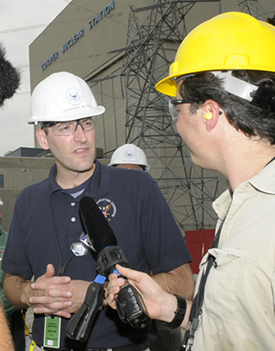As water levels of the Missouri River rise and flooding continues to devastate many areas of the Midwest, officials at Cooper Nuclear Station assure the power plant is “reliable and ready.” Located in Brownville, Nebraska, Cooper Nuclear Station (CNS) is built high above the flood plain, sitting 2.5 feet higher than the levees, 70 miles south of Omaha, Neb.
 Heartland has a purchase power agreement with Nebraska Public Power District (NPPD) to purchase 45 megawatts from CNS. NPPD, headquartered in Hastings, is the plant owner and operator.
Heartland has a purchase power agreement with Nebraska Public Power District (NPPD) to purchase 45 megawatts from CNS. NPPD, headquartered in Hastings, is the plant owner and operator.
CNS and NPPD officials promise, “Safety is our number one priority.” CNS staff continuously monitor river water levels as part of normal operations. In anticipation of the U.S. Army Corps of Engineers’ release of higher volumes of water, personnel began preparations on May 30, including filling nearly 10,000 sandbags for barricades and reinforcing the plant’s access road. Personnel have erected roughly 800 barriers around the station.
Should the river’s level increase to 900 feet above sea level, internal doorways will also be barricaded for additional protection for facility equipment. At 902 feet above sea level, CNS will be taken offline as a protective safety measure. CNS is at an elevation of 903 feet.
In addition to prevention, the plant design and “defense-in-depth” strategies are also defenses against emergencies. Multiple safety systems provide redundancy in the station’s power supply, including two emergency diesel generators to provide back-up power, a portable diesel generator to charge battery tanks and a third supplemental diesel generator available if the first two fail. This third generator can handle site flooding up to 905 feet above mean sea level.
A new, 161-kilovolt line and substation is also currently under construction at the plant. This will improve access to off-site power and serve as a redundant power supply for both the start-up and emergency station transformers.
Other prevention and emergency response measures include a spent fuel pool, dry cask storage facility and portable pump and motor.
On June 19, CNS declared a “Notification of Unusual Event” as part of standard procedure to address rising water levels. The notification was declared “as part of a safety and emergency preparedness plan the station follows when flooding conditions are in effect. The plan’s procedures dictate when the Missouri River’s water level reaches 42.5 feet, or greater than 899 feet above sea level, a notification of unusual event is declared.” NPPD and CNS operators assured there was no threat to plant employees or to the public.
A notification of unusual event is the lowest and least serious of four emergency classifications established by the Nuclear Regulatory Commission (NRC) for nuclear power plants. NRC Chairman Gregory Jaczko toured CNS June 26 as part of a two-day review of Nebraska’s flood-threatened nuclear stations. He concluded the plant “is operating safely.”

NRC Chairman Gregory Jaczko visits Cooper. (Courtesy Nebraska Public Power District)
NRC invited national media to CNS for Jaczko’s visit. For a sampling of the media coverage, click here.
NPPD has set up a Flood Information Center webpage that contains flood facts and information, including the precautions they are taking at CNS and other power plants. CNS has also issued a “Reliable & Ready” fact pamphlet that explains in detail the systems and processes that keep Cooper operating safely.


